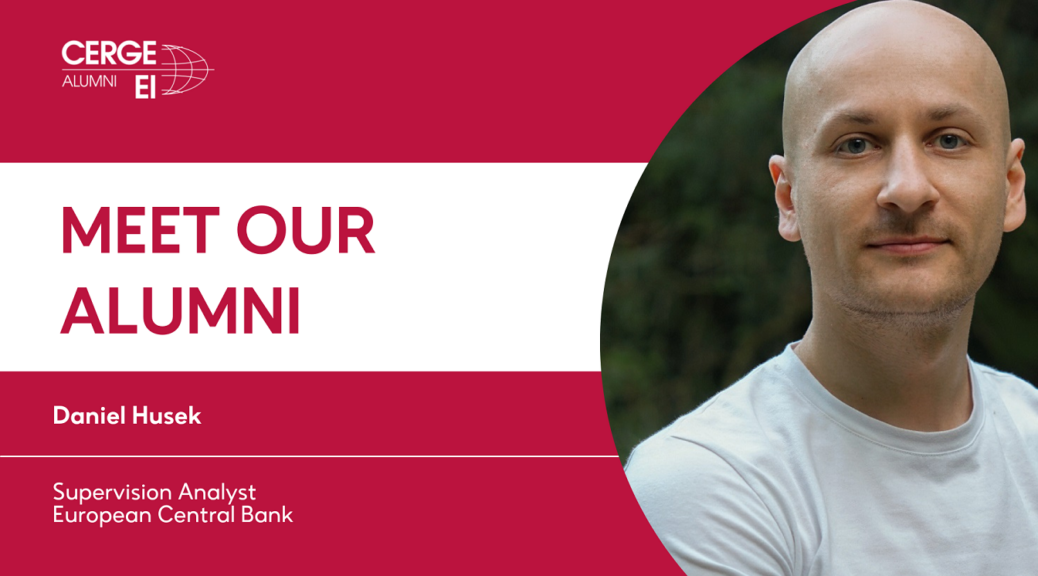For over six years, CERGE-EI alumnus Daniel Husek has been a part of the European Central Bank, contributing to microprudential banking supervision. Join us to explore his experiences and insights gained during this time in the new alumni interview.
For more than six years, you have worked at the European Central Bank. Can you tell us more about your work there?
Time flies. The content of my work has evolved over the years, but since the beginning, it has been linked to microprudential banking supervision, specifically to the assessment of the quality of the internal models employed by some banks for their capital adequacy calculations. Although this may sound complex, it is surprisingly simple to explain, though some background is beneficial.
One of the mandates of the ECB is to directly supervise eurozone banks that have the potential for significant impacts on the economy. It is no surprise that individual banks face various types of risks. Given that their business is linked to granting loans, the largest portion of risk is associated with the scenario where a subset of debtors cannot repay in full, known as credit risk. Part of this risk can be anticipated, and banks transfer it to the pricing of loans or accounting provisions—buffers for expected losses. However, for efficiency reasons, it is impractical to hold extensive additional buffers for unexpected difficulties. Not holding additional funds could jeopardize the deposits of bank clients, which is where regulation and supervision become relevant.
Regulation requires a bank to hold more of its own funds the greater the risk it faces. To determine how much of its own funds a bank needs to hold, the bank has two options: it can either categorize its loans and other credit risk assets and then search for the corresponding requirements in regulatory tables, or it can develop models to assess the risk. These models are called internal because they are sourced by the bank. Given the importance of the banking sector in Europe and the fact that large banks frequently apply the modeling approach, understanding and supporting the quality of these models by authorities significantly impacts the stability of the banking sector. Assessing all attributes of these models—from their methodologies through their performance to their management—is the aim of the group I am part of.
What are your primary responsibilities as a Supervisor in the Credit Risk Experts Division? What projects do you work on?
The content of my job is largely dynamic and reflective of the current situation in the market, but there are two stable projects I can give you a flavor of. Apart from directly assessing the methodology of models, one supervisory stream involves indirectly assessing the internal models using confidential data. Without knowing the correct underlying risk of a client, it is challenging to question a bank if it underestimates risk. By juxtaposing risk estimates across banks on data granular enough to control for the underlying risk, we can identify banks and models that are likely too progressive or too conservative. Naturally, there is an asymmetry in focus: holding too much of its own funds does not harm a bank in preventing failure, but a bank does not escape scrutiny if it estimates unrealistically large losses.
Another project aims to promote the quality of modeling directly within the bank. Fortunately, supervisors are not the only body to investigate the functionality of the models; each bank has its own team to perform this task as well. The project’s goal is to assess the quality of this work. This involves collecting the validation reports of the banks, complementary supervisory data, running a set of statistical tests on the models, and comparing the results with the banks’ validation function assessments.
In both projects, I am responsible for running a network of experts from national supervisory authorities, maintaining the data infrastructure, co-developing assessment methodologies, and supporting follow-ups on issues found with banks.
What emerging trends or challenges do you foresee in credit risk analysis and regulatory compliance, the field you currently work in?
One interesting trend to mention is the adoption of granular data and the combination of various information resources to make better, data-driven decisions on complex topics. For example, risks stemming from climate change are increasingly affecting the ability to repay debt. Supervisory authorities can exploit confidential central credit register data alongside environmental sources, allowing supervision to become more integrated.
There is also a continuous trend towards efficient supervision, largely influenced by the current wave of artificial intelligence-based tools. These tools simplify standard tasks for supervisors, allowing them to focus more on valuable details, thus making supervision deeper.
Another emerging trend is the need for supervision to be promptly reactive to current market events. Whether it is issues in the Chinese real estate industry, a global pandemic, or economic sanctions affecting European businesses, supervisors need immediate knowledge of which banks are impacted and whether they are prepared for the consequences. Therefore, I see a trend towards faster supervision as well.
What would you say are the key attributes or skills that aspiring supervisors and supervision analysts should focus on developing?
The team of colleagues I work with have diverse backgrounds, ranging from economists and statisticians to physicists and software engineers. Supervision analysts and supervisors benefit from being technically skillful, but the work ultimately deals with people, where focus on soft skills, time management, clear communication, and balancing negotiation around divergent views is crucial. Observing the variety of individuals, their skillsets, and personalities, I recommend taking advantage of opportunities at CERGE-EI to work within diverse multicultural teams and learn to build on each other’s differences. Furthermore, given the trends mentioned, focusing on data science and AI technologies would currently give a supervisor a competitive edge.
What from your CERGE-EI studies has influenced you the most?
I believe it is not a single influencing element but rather the complete environment—classmates, coursework, professors, and institute staff—that largely shaped my way of thinking. Very few news items are not filtered by considering their potential motives, and when evaluating the impact of a change, I also tend to put more thought into the incentives it alters. I notice these traits have evolved over time and are less present among my friends who were not trained at CERGE-EI, so you may consider it a result of my difference-in-differences analysis.

